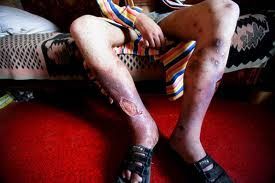DEA Remains Skeptical Of Russian Flesh-Eating Drug 'Krokodil' While Reports Of Nightmare Drug Spread Across US [VIDEO]

Despite sporadic reports, the U.S. Drug Enforcement Agencey (DEA) maintains that Krokodil — a drug concoction made by cooking codeine with chemicals including gasoline, lighter fluid, and industrial cleaners — has yet to surface in the country.
The U.S. Drug Enforcement Administration says it has received no reports of the drug in the United States but continues to monitor the epidemiological spread overseas in Eastern Europe. “We, the DEA, are not seeing cases of it,” spokeswoman Dawn Dearden told Fox News. “Nothing’s been turned into any of our labs. As far as the DEA is concerned, we have not seen any cases.”
The Russian bogeyman, the latest to threaten public health, is used as a cheap alternative to other drugs in poorer rural parts of Russia and has spread in popularity to Germany. As many as one million people in Russia have used the drug, according to the New York State Office of Alcoholism and Substance Abuse Services.
Highly addictive, the drug compound contains hydrochloric acid and red phosphorus, which causes severe tissue damage and injury to the veins, in addition to gangrene. Like similar codeine-based drug concoctions, Krokodil causes severe withdrawal symptoms; its injectable delivery facilitates the spread of HIV. The synthetic version of desomorphine, a drug invented in 1932, Krokodil represents a deadly public health threat rivaling America's longstanding problem with crystal methamphetamine.
Despite the DEA's attempt to downplay the prevalence of the drug, reports of the drug sporadically surface. An addiction treatment center in Joliet, Ill., claims to have seen four cases, including two patients still under treatment. Abhin Singla, director of addiction services at Presence Saint Joseph Medical Center, told reporters they’d treated three hospitalized patients this week for using the drug, a synthetic form of desomorphine reputed to be ten times as powerful as morphine. The drug is also said to be three times as potent as heroin, at approximately one-third the cost, with a high lasting a few hours. A report from CBS News stated that Krokadil users often die within two years of first use.
"If you want to kill yourself, (using) this is the way to do it," Singla said, adding that he’s spoken with the DEA office in Chicago about the cases, in addition to reports of the drug in Utah and Arizona.
The DEA declined to comment to reporters further about reported cases in Illinois, Utah, and Arizona.
The center treated the fourth patient this week, spokeswoman Jan Ciccarelli told reporters. Two of the first three patients, however had left the center against advice of doctors, she added. The three initial patients treated by the center were young women from the area, all under the age of 25. Although none of the patients would identify the source of the drug, workers at the center ascertained that two of the three were acquaintances, indicating they might have obtained the drug from the same source.
The patients were all devastated by the drug, with one woman facing years of surgeries in hope of restoring her ability to walk. "It's a horrific way to get sick,” Ciccarelli told reporters. “The smell of rotten flesh permeates the room. Intensive treatment and skin grafts are required, but they are often not enough to save limbs or lives."
Below is a report from CBS on Krokodil in the U.S.:



























